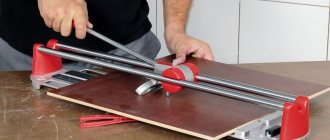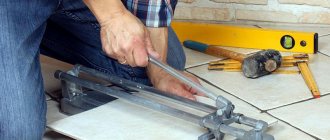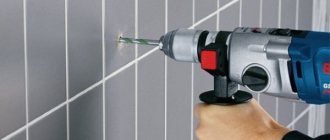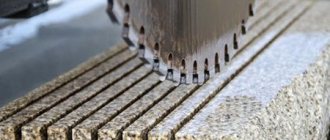Ceramic tiles are one of the most popular wall and floor coverings in kitchens and bathrooms. The high demand for decorative material is associated with its durability, cost-effectiveness and wide design variability. But it is impossible to perfectly calculate the tile so that it fits everywhere without having to cut it. Let's figure out how to use a manual tile cutter.
What is a tile cutter and why is it needed?
Many people have no idea what a tile cutter is and why such a tool is needed at all. If we consider this issue in more detail, then this is the most common device that allows you to quickly and accurately cut ceramic tiles. Today, both manual and electric tools are actively used in construction. It is worth noting that you can easily cope with the operation only if you use a manual tile cutter, but with the electric version some difficulties may arise.
What to look for when choosing a tile cutter video
Even if we consider that both types of instruments have the same name, they are not at all similar to each other. The only exception, of course, is the final result of using the tool. In order to be able to use a manual tile cutter, you need to use it to make furrows (the unit has very sharp cutters), and then make a break in the tile. In turn, the electric type of tile cutter works with a battery or from an electrical network and, in its appearance and operating principle, can be a little reminiscent of a circular saw. The tiles are cut using a very sharp diamond blade, which has an incredibly high rotation speed.
Main criteria when choosing a tile cutter
When choosing a tile cutter, you should pay attention to the following characteristics:
- Bed size. The tool is used to work with both wall and floor tiles. Today, the building materials market offers a large number of decorative elements of different sizes and shapes: from squares with a side of 10x10 cm to decorative panels. For home use, the optimal base length will be 40 centimeters or more (remember that some elements will have to be cut diagonally or obliquely).
- Reliability of the frame and guide supports. The quality of its work largely depends on the strength of the tool’s base. It should not play or sag when pressing with your paw on the tile. Otherwise, the tool will simply be unsuitable for further use. The supports must be well adjusted and securely fix the guide rods without any play - the carriage must move smoothly so that the cutter cuts the glaze exactly along the chip line.
- Carriage movement. The carriage along the guides should slide along the guides smoothly, without jolts. This will ensure the cutter operates correctly and efficiently. The type of carriage (sliding, on bushings or bearings) must correspond to the load and volume of work for which you plan to use this device. A manual porcelain tile cutter must have a strong handle to provide enough force to split the tiles. Possibility of adjustment. Tiles have different parameters and characteristics, therefore, to obtain a high-quality result, the tool must be able to be adjusted to any type of material.
In order to have a starting point when choosing, we suggest considering the rating of the best manual tile cutters.
Basic design and technological capabilities
Tile cutter is a generalized name for construction tools for straight, curved or even shaped cutting of tiles. The classification of the variety of these tools is based on the type of drive movement. So, tile cutters can be:
- Manual;
- Mechanized or electric.
A manual tile cutter consists of a base - a frame, a carriage with a roller and a handle. Its operating principle is similar to that of a regular glass cutter: a cutting roller is used to cut the glaze of the tile. At this moment it is clamped in the body like pliers. After obtaining a cut of the glaze, the tiles are broken off along it. To obtain a more even and accurate cut, guides are used that are adjusted to the tile clamping field. Sometimes tabletop manual tile cutter
An electric tile cutter is a device equipped with an electric drive that rotates a diamond cutting disc. The principle of operation of this version of the tile cutter is similar to a circular saw - the ceramic tiles move along the guide to obtain an even and neat cut. One of the varieties of mechanized tile cutter is a belt cutter, equipped with a diamond belt. To cool the tiles, water is supplied to the cutting area, which also washes away the cutting products.
In order to cut ceramic tiles correctly, you need to know how to use a tile cutter correctly .
Manual tile cutter device
A stable stamped bed with sufficiently heavy weight and rigidity along the axis of the base, which serves as a support for the tool itself, on which the tiles for cutting are laid, has a rubberized surface of the base, which eliminates the possibility of slipping during the cutting process. A frame body that is weak in strength will lead to vibration when the tiles split, which will lead to the rejection of consumables and damage to the tool itself.
The bed is firmly connected to two metal guides in which the carriage is fixed - the main working element, the components of which are:
- Lever handle. A strong handle gives more powerful leverage, which is especially valuable when working with porcelain stoneware.
- Carbide replaceable cutting wheel. The surface of the cutting roller must be of a regular round shape, without flaws, burrs or gouges. When the roller becomes dull, the cutting quality drops significantly - sharpening the cutting roller is impossible; the dull one must be replaced.
- A foot that holds the workpiece from accidentally shifting while pressing.
The guides and lever are made of durable steel and silumin, which have the necessary characteristics for the applied pressure: strength and rigidity. Additional elements are made of high quality plastic.
Some models have a scale for selecting the size of the tile; the accuracy of the size is fixed with thumbscrews (it is very convenient for left-handed people to use a tool with a mirrored double scale). The presence of a rotating ruler in professional models of tile cutters allows you to cut tiles at an arbitrary angle for shaped processing of the workpiece.
The tile cutter can be mounted on any flat, stable surface using bolted connections for ease of operation and additional rigidity when working with tiles of a sufficiently thick width - for this purpose, technological holes are provided on the bed platform.
Useful tips and general recommendations
Additional tips for cutting tiles:
- before starting work, the workpieces can be kept in water for 1 hour; high humidity simplifies the cutting of elements;
- To apply markings, it is recommended to use a permanent marker or a pencil with a grade B soft lead;
- when using a cutting tool, it is necessary to perform the notch in 1 pass;
- to ensure smooth running, the roller axis is lubricated with machine or engine oil;
- when using an angle grinder, you should select wheels designed for the spindle speed;
- sharp edges on the tiles are dulled with sandpaper or a coarsely cut metal file.
When working with electrical equipment, wear safety glasses and gloves. There are no ribbons allowed on clothing that could get wrapped around the rotating disc or crown. The room must be equipped with a ventilation system; work may be carried out in the open air. Electrical wiring should not lie in puddles or be filled with liquid used to remove dust and cool the drive.
Manual tile cutters differ in body material and dimensions, which determine the permissible size of the tile. A small-sized tool is suitable for household use, but it will not be possible to break tiles more than 5 mm thick or porcelain tiles. If excessive force is applied to the lever, the aluminum guide brackets break. Professional models with a price of up to 20 thousand rubles are suitable for cutting thick workpieces. The equipment is distinguished by a steel sole, reinforced bracket design and increased cutting tool life.
Classification of manual tile cutters
To cut tiles in small quantities, you can use hand tools. It is much more convenient to cut tiles in large volumes using electrically driven devices.
Based on the design features, the following types of manual tile cutters are distinguished:
- Roller. The simplest device in which a carbide roller is used as a cutting element.
- Mechanical. The tool is equipped with a rigid carriage, thanks to which you can cut with extreme precision.
- On bearings. The smoothness of the cutting action is determined by the presence of bearings on which the bushings are installed.
Cutting tiles can be done either with hand tools or with an electric tile cutter, grinder, wire cutters, or glass cutter. This can even be done with a jigsaw, but it is better to use devices specially designed for this, as they allow you to achieve the desired quality of cut.
Which tile cutter to use for cutting
There are two types of tile cutters: these devices are electrical and mechanical. The first type is suitable for industry or construction work. Manual models are used for cutting tiles at home.
There are three types of household tile cutters:
- Roller. The device consists of a handle and a cutting roller. It is used as a separate tool or used in conjunction with a saw station.
- On bearings. This option is used when it is necessary to cut durable ceramic tiles with a thickness of more than 16 mm.
- Mechanical. Thanks to the presence of a rigid carriage, the device can be used to perform precise cutting.
Important! No model will be able to cut a strip from the very edge if the width required is less than 10 mm. In this case, the worker will need to use wire cutters.
While working with the tool, the master should not be distracted by anything
How to use a manual tile cutter correctly
To use a manual tile cutter correctly, you should be guided by the following technology:
- Draw a marking line on the front side of the tile using a marker or felt-tip pen.
- Fix the material using special clamps, while the marking line should be located exactly under the cutting wheel.
- Place the cutting element at the beginning of the marking and lightly press it.
- Holding the handle, smoothly move the carriage away from you along the cutting line. The pressure should be strong enough to cut the glaze. If you apply great force, you can break the tile or damage the glazed layer at the cut site. Insufficient pressure will not allow you to disturb the hard coating and then break the tile.
- Move the handle to the middle, lower the lever (if included), then press it or hit it sharply. If there is no lever, the tile is placed on the edge of the table along the cut line and broken by pressing on the part protruding beyond the edge.
If everything was done correctly, the tile should break neatly exactly along the cut line. Some models have a built-in ruler and swivel base for cutting tiles at a 45-degree angle. More details in the video:
Preparing for work
Before you start sawing porcelain tiles, glass or tiles, you need to prepare the working tool, and in some cases, set it up.
Any instrument is first inspected for external damage. For mechanical models, check:
- condition of the roller - free rotation, presence of defects, sharpness, reliability of fixation;
- smooth running of the carriage, presence of play;
- the frame for the presence of contaminants, removing them if necessary;
- defects on the handle;
- if there is a stop, then measure the angle between it and the axis of the cut.
The cutting roller must rotate freely, be clean and of the correct shape (no gouges or dents). It should be sized to match the thickness of the tile being cut.
After preliminary checking and cleaning, apply a small amount of lubricant (machine oil) to the guides and cutter. Then, using a construction pencil, marker or felt-tip pen, marking lines are applied to the surface of the tile materials along which the cut will be made.
If the modification is equipped with a stop and a measuring ruler, then markings are not necessary.
Before cutting the tiles with an electric tile cutter, check that the disc is securely fastened. The contaminated disk is cleaned of adhering particles of debris. If the power tool is equipped with a water cooling system, then maintain the presence of liquid in the required quantity. Dirty water is replaced completely so that the cutting area is well cooled.
For electrical equipment, the power cord must be intact and dry: only in this form is it permissible to insert the plug into the socket. Also, during operation of the device, water circulating in the cooling system should not fall on the cable. After the electrical equipment is operational, you need to ensure the continuity of the fluid supply.
The power tool is usually adjusted at the factory, but the settings may change during transportation. For this reason, it may be necessary to adjust the cutting angle and the length of the blade's working movement. The adjustment of each model has its own characteristics. The process of setting up the installation used is described in the operating instructions for it. To set angles you will need to use a protractor, protractor or square.
Pros and cons of the manual model
The undoubted advantages of a manual tile cutter include:
- independence from the power grid. This device can also be used where there is no electricity or it is temporarily turned off. When working in wet areas - for example, when tiling a bathroom, swimming pool, sauna - the ability to cut tiles directly at the workplace, without going into another room with a working outlet, is very important;
- no temperature restrictions.
- Injuries when using the device are practically excluded. Maximum – damage due to accidental fall of the device on the leg or pinching of a finger;
- mobility. The products are small, even the largest options, weigh up to 1...3 kg, are easily transported and do not require special conditions of transportation and storage.
The main disadvantages are:
- the difficulty of cutting small strips along the edge of the tile. If the distance from the edge to the cut is less than 3 cm, only an experienced cutter using hand tools will be able to make an even cut;
- problems when working with tiles of non-standard sizes. Both very small and very large specimens are difficult, sometimes impossible, to cut;
- the need to exert physical effort to make the cut.
Other possible shortcomings depend rather on the specific model chosen:
- tile fracture due to excessive depreciation;
- excessive force resulting from insufficient lever length;
- insufficient size of the working area;
- uneven movement of the carriage;
- difficulty in replacing the roller (cutter) or its insufficient quality.
These points (except for the last one, it is not always possible to check the quality of the cutter in a store) should be paid attention to when purchasing.
Content:
- 1. Organization of the workplace
- 2. Operating principle
- 3. Maintenance and repair
- 4. Safety rules
To ensure a smooth tile cut without chips or nicks, it is important to follow a few simple rules. Read on.
There are many ways to cut tiles, glass or stone (using a jigsaw, circular saw, etc.), but special equipment - a tile cutter - is most effective for this type of work. If you work with it correctly, it will take less than a minute to cut one tile, while other methods will require from 5 to 10 minutes. What is important to consider when working with a tile cutting machine? What rules should be followed to ensure high productivity and minimal risk of injury or material damage? Let's look at it in order.
Workplace organization
This is an important point that will ensure proper convenience and performance and guarantee your safety.
- The workplace must be sufficiently lit.
- Tools for setting up equipment and measuring operations must be removed from the workbench. If they get under a saw blade or just under your hand, they can cause injury. The best option would be to organize a special storage place, for example, a tool cabinet.
- Strangers should not be allowed near the equipment, especially if it is electric. While working, keep people at a safe distance. Shards and dust can be dangerous
- Make sure that shavings, crumbs, etc. do not accumulate on the floor.
- If the equipment is electrical, it is strictly forbidden to use it in rooms with high humidity (basements, warehouses) to avoid electric shock.
How to cut tiles with a manual tile cutter
Several types of manual tile cutters are used to cut tiles. Having chosen a tool in the form of tongs, you should carefully cut with a diamond cutter along the front side of the tile, then use a corner to break it into two fragments.
Using a desktop manual tile cutter, you can quickly cut tiles up to 15 mm thick. To do this you need:
- Use a felt-tip pen to mark the workpiece;
- lay the tiles on the base of the glass cutter, while its wheel should coincide with the markings;
- while operating the handle of the tool, pass the wheel once along the marking line;
- fix the tiles using wings on both sides;
- lightly hit the handle to get the desired segment. If after several blows it does not give in, it is better to repeat the cutting on another specimen.
Attention! It is easier to cut a narrow fragment from a ceramic workpiece if it has a dense structure.
If you need to make rounded holes on the tiles - up to 80 mm in diameter, this can be done with a tile cutter with a circular cutter. Wetting the workpiece with water will help improve cutting accuracy.
Recommendations for working with a tile cutter
We insert the tile into the tile cutter, align the markings on the tile and the special mark on the tool. We lower the handle and move it away from us with a smooth movement. The speed should be the same, the pressure should be uniform, then the glaze will be cut to the same depth. One cut with a roller is enough. If the movements are repeated several times, we can get a poor-quality fracture.
The tool is equipped with special claws, which, when lowered, break the tile into pieces of the desired size. The main thing is to press the lever sharply. All tile cutters, without exception, have a platform with a metal tubercle and soft linings.
When pressing with your paws on the edge of the tile, the cut is under maximum pressure. If the cutting line and the lining are correctly aligned, the tile will split very smoothly.
In words, this process may not be entirely clear, especially to beginners. It’s better to look visually and understand how to cut tiles with a tile cutter correctly.
Cutting tiles with the letter L
The tile cutter is designed to make straight cuts only, so if you need to make an L-shaped cut, you will have to work a little harder. The easiest way would be to cut the tiles into two parts, and then one of them again and fold them in an L shape when laying.
And as a result, we get an additional seam that no one needs, which is very noticeable.
You can go the other way - the short side is cut using a grinder, the long side is cut with a tile cutter.
This method is also suitable for cutting off external corners, the main thing is to mark it correctly and subtract about 5mm + grout joint + a slight indentation from the wall.
There is another way: a cut on the surface of the glaze is made using any available cutting and piercing object, and then the excess is broken off using pliers. To smooth out uneven surfaces we use sandpaper. In this way, you can make round cuts that are placed near the risers.
We cut porcelain tiles
Everyone knows that porcelain stoneware belongs to the group of the hardest materials used for the production of floor tiles. The cutting method for it is the same as for standard tiles.
Often, floor tiles are much less easy to cut than porcelain tiles themselves. This is especially true for hardened tiles, where it is almost impossible to see the cut on the surface of the glaze. Often, even with a diamond blade, it is not possible to make an even cut. In this situation, we take a grinder, cut out a groove of 2 to 3 mm on the back side, which will be the break point.
How to cut tiles with a manual tile cutter?
Before you start using a manual tile cutter, you need to carry out a number of preparatory work that have a direct impact on the final result.
Preparing the tool for work
Process:
- Inspect the product for any damage. Watch the video - there should be no bends or nicks. Otherwise you will have to replace it with a new one.
- Pay attention to cleaning the device, not forgetting to wipe the guides and the surface of the bed.
- All nuts and bolts need to be tightened.
- Lubricate the carriage with oil if there are problems with its movement.
Marking
To work at this stage, you will need a pencil/marker with which you need to draw a fault line. In the future, the tool will need to be fixed so that the cutting element is located exactly above the drawn line.
Tile cutting technology
So, how to properly cut tiles with a tile cutter? To obtain an even cut, follow the technology:
- Cover the tiles with a wet cloth or soak them in water for 1-1.5 hours. In this way, it will be possible to make the ceramics more pliable and avoid crumbling.
- Fixing the tiles. There are models of tile cutters that have clamps - they will take care of the immobility of the die. If there is no such element, you need to support the material with one hand. The cutting element must be located exactly above the future fault. If the die is large, you can put something under its edges to prevent it from wobbling.
- The cutter should be at the very beginning, on the edge of the tile (where the line is drawn).
- During the cutting process, make an effort so that later it will be easier to break the die into two parts.
Fault
After cutting, carefully and slowly press the lever. The tile should break exactly along the line.
Features of cutting using a rack tile cutter
Before using a rack tile cutter, you should become more familiar with the design features of the tool. If we are talking about a professional model, then during operation you can remove the cutting device and check its sharpness. This tile cutter has a base and tubular runners along which the cutting element made of hard alloy will move. You should not go through the same cutting area several times, as the result will not be positive. In order to get high-quality tiles after cutting, you should be able to break the material correctly. There is a tubercle on the base, with the help of which the edges of the ceramic product are raised above the surface. Thanks to this addition, you can break the product by placing it on the ledge. Among other things, the ceramic can be broken using a T-shaped foot, which is located in front of the roller. This heel is installed in the center of the cut so that when the lever is pressed, it presses on the blade. With this tile cutter you can cut through the material diagonally.
Safety precautions
You need to know how to safely cut tiles with your own hands and how to avoid possible injuries. There are a number of requirements that must be met:
- Inspect the tile cutter for functionality and damage.
- Check the carriage stroke. It should move smoothly, without jerking.
- The guides must be even and smooth, without damage.
- The cutting disc must have a smooth surface, without burrs or gouges. It should rotate on the axis freely, without creaking or getting stuck.
For safety reasons, you should use protective plastic glasses and fabric gloves.
Tips for using the tool
- If you are choosing a tool for one-time use, an inexpensive model, for example, from a Chinese manufacturer, will do. For reusable use, it is advisable to buy a manual professional tile cutter - it will last for many years.
- Regardless of whether you are cutting porcelain stoneware with a tile cutter or ceramics, take into account the diagonal length of the die. It is desirable that the length of the working section be greater and in no way less than the diagonal of the finishing element.
- Before you start cutting, you need to drip machine oil onto the surface of the roller. This solution will significantly reduce the friction between the roller and the die - this will help improve the quality of the cut.
- To ensure that the break turns out the way it should, do not rush, do not make sudden movements. The movement of the crown should be smooth and unhurried. Make sure that the box does not get stuck while driving.
- Pay attention to the roller, it should not have a loof.
Maintenance and repair
Maintaining any tile cutter primarily involves cleaning it after use. There should be no pieces of material or crumbs left on the table. In addition, it is necessary to clean the cutting tool itself from adhering dust. This is especially true for saw blades. To clean the disc, you can make a few cuts on the grinding stone or turn the disc over so it rotates in the opposite direction. Just before you do this, look to see if there is a direction indicator on the equipment - if there is one, this cleaning method cannot be used.
Repair of a tile cutting machine should be carried out by a professional, so if a serious breakdown occurs, take the equipment to a service center. Of course, there are a number of malfunctions that the user can fix on their own. Here we will again talk about electrical equipment.
| Breaking | Alleged cause | Remedy |
| The equipment vibrates | There are chips or unevenness on the disc. | Inspect the equipment, it should be intact and even. |
| The disk is not securely secured. | Check the flange nut to ensure it is securely tightened. | |
| The disc makes a figure eight when rotating | Accessories installed incorrectly (for example, discs with a certain direction of rotation). | Inspect the disk for stampings and turn it over. |
| The disk does not fit the equipment. | Replace the drive. | |
| No water supply. | The pump is clogged and the supply hose has ruptured. | Remove the screen, clean the funnel and pump installation area, and inspect the hose for severe kinks or breaks. |
| The engine stops periodically. | The engine has overheated. | Reduce the load on the tool. |
| The fuses are blown or their power is insufficient. | Install fuses that match the power of your equipment. | |
| The engine is not running at full power | The extension cord is too long. | Check the mains voltage. |
| The extension cord is too long. | Use a suitable extension cord (see operating instructions for information). |











